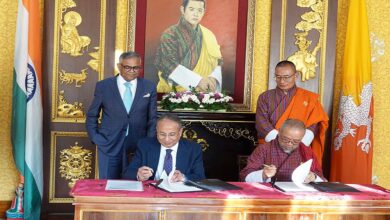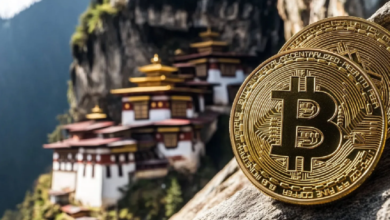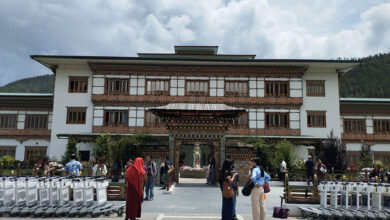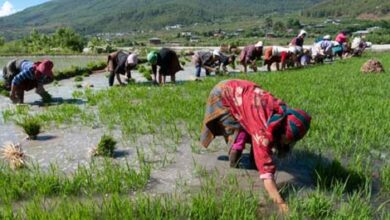The Trans Bhutan Trail, recently reopened after 60 years, already tops the list for adventure and history seekers. Travel+Leisure India & South Asia’s contributor hikes a part of this ancient route and comes back with legendary stories and a renewed love for the country. By Japleen Kaur
“I am thanking my mother a thousand times on getting back home,” said Chimi, the 60-plus-year-old tourism guide. Years ago, her mom had walked a part of the trail to Punakha Valley from their farms in Paro, which took close to three days, while she was pregnant with Chimi, and a simple three-hour-long hike made us realise that it was no easy feat. Like her, most of the locals of Bhutan have grown up with tales surrounding the Trans Bhutan Trail. It was closed in the 1960s when Bhutan introduced its national road system, until September 2022. Almost six decades later, the people of Bhutan are taking to the trail again. Along with them are tourists who want to experience a slice of history.
The Trans Bhutan Trail Reopens
Tourism in Bhutan opened on September 23, 2022 after a long pandemic lockdown. I was one of the first foreigners to enter the country. But what made it truly special was the reopened Trans Bhutan Trail. A 403-kilometre-long route that starts from the district of Haa in the west of Bhutan to Trashigang in the east, the trail connected different fortresses, called dzongs, to each other and was also the route that monks took to travel from one district to another. Garps or post messengers used the trail to carry messages and mail on foot, aiding in uniting many provinces, ultimately initiating the birth of Bhutan as a nation in 1907.
Until 2020, the trail that dates back to the 16th century, was in ruins with overgrown flora, collapsed wooden bridges, and a highly treacherous terrain. The project envisioned by His Royal Highness, the fifth King of Bhutan, Jigme Khesar Namgyel Wangchuck came to life when the Bhutan Canada Foundation and Tourism Board of Bhutan joined hands. As Sam Blyth, the founder of the Bhutan Canada Foundation rightly said in his commencement speech, “Sixty years is a short time in our natural history, but an age in the life of a trail.” The task of restoring this extremely important route was done by highly skilled experts and 900 volunteers, or dusuups, as they are known in Bhutan. Dressed in orange jumpsuits, they are ready to help anyone who are on the trail. I fell down twice while hiking, and almost instantly a makeshift stick was handed over to me along with motivating words!
I did two hikes of three hours each. The first one was from Dochula Pass (3,100 m) near the capital city of Thimphu till Thinleygang near Punakha. Barring a few instances, this particular route was a steep downhill descent into the valley. We crossed rhododendron trees, tiny waterfalls, a lone village with scarecrows in the fields, and wild mushrooms. The trail is dotted with around 170 signposts with QR codes, giving you all the information of the region including personal stories of the nearby villages. What is interesting is that Bhutan’s constitution has a mandate for 60 per cent of the nation to remain a virgin forest; currently, about 70 per cent of the kingdom is covered by uninterrupted greenery.
The hike ended at a campsite, leaving me breathless but also in complete awe of the beauty we were surrounded with. Bhutan is one of the least visited countries in the world, and walking this trail was well worth the sore limbs. Pro tip: if you want a sound sleep out in the wild, I recommend carrying ear plugs as the dogs tend to bark into the wee hours of the night. Rochis, as the dogs are called in the local language, are an essential part of the nation where they are treated as true companions.
The 403- kilometre long trail will take an average fit person close to 34-36 days to complete. But the good part is, one can choose between day hikes and a seven-day trek. You can consult with the TBT team and design a route that is feasible for you. We did leave the trail often to head to some of the marvels that Bhutan has to offer. An afternoon was spent in the stunning valley of Punakha, visiting the famous fertility temple, Chime Lhakhang. This is where phalluses are worshipped and people come from afar to be blessed with an offspring.
We also made our way to the mighty Punakha Dzong, situated at the confluence of the Mo Chu and Pho Chu rivers. Bhutan’s oldest and longest suspension bridge is located right behind the dzong. During one of the days of the trip, we walked on the busy roads of Thimphu and realised the stark contrast of the walks we’d been on till then. The world’s largest sitting Buddha statue is located in Thimphu, and is worth visiting.
The second route that we went on was post the opening ceremony at Semtokha Dzong, the oldest monastery in Bhutan. The buzz of the chants, aroma of camphor, light from the butter lamps, and the taste of savoury tea still linger in my mind. Not only did we hike the most picturesque trail—along a gurgling river, crossing chilly farms and apple orchards, and wooden bridges—we also walked with esteemed dignitaries including Prime Minister Lotay Tshering, monks from all over Bhutan, members of the government, and the 24 scouts who were on their way to become the first group to complete the entire trail since its reopening. By the time you read this article, these scouts would have, hopefully, accomplished the mission.
The Trans Bhutan Trail is as much about seeking adventure and testing your endurance levels, as it is about the people and their connection with nature. In its attempt to promote the concept of ‘less is more’, Bhutan has always positioned quality over quantity when it comes to tourism. With every step you take in this nation, you will understand the need and meaning of this vision.
The true ethos of Bhutan lies in its individuals—the kind and honourable Prime Minister who led by example and hiked 40 odd kilometres in two days; our guide Chimi who thanked her ancestors after every step; the young guide Thenthuk who was seeing most of his own country for the first time as he walked the trail with us; the scout who slowed down to keep me company when I’d lost all hope of reaching the finish line; and more.
And somewhere between the conversations with these individuals and the spellbinding beauty all around, you will realise why Bhutan is one of the happiest countries in the world.




